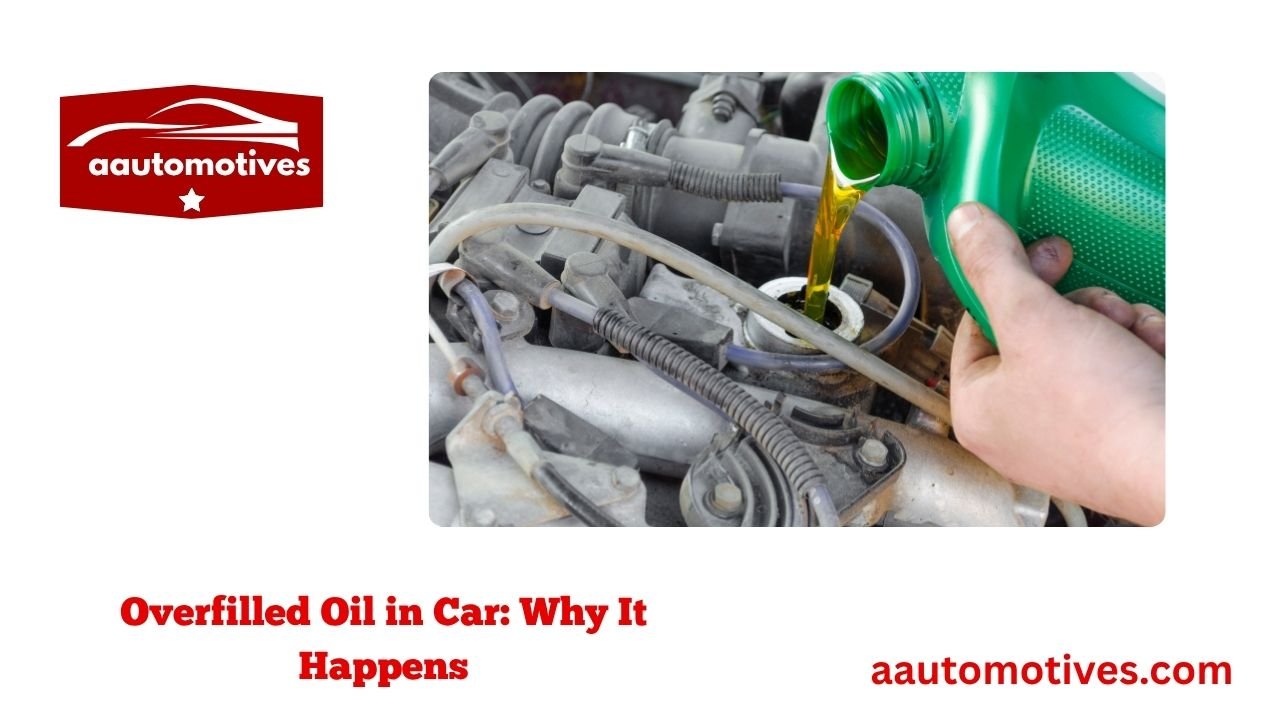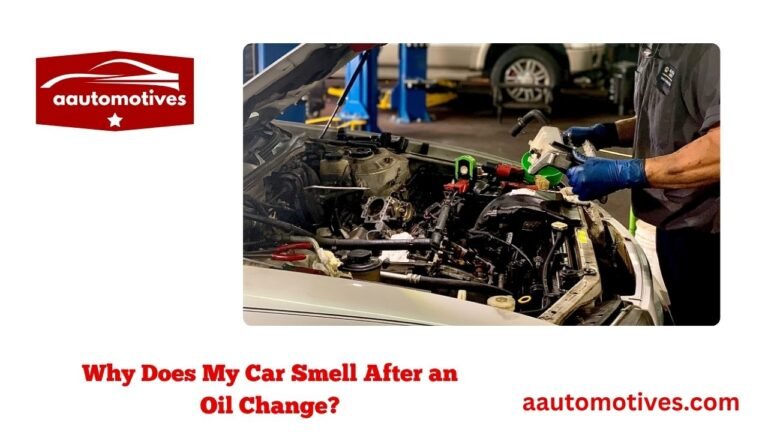Overfilled Oil in Car: Why It Happens

Have you ever popped your car’s hood, checked the oil dipstick, and noticed it’s way past the “MAX” mark? That moment when your stomach sinks? Yeah, I’ve been there. It’s easy to assume a little extra oil won’t hurt. After all, more lubrication sounds like a good thing, right?
Wrong.
In fact, an overfilled oil in car can cause more damage than low oil. It might seem harmless at first, but the effects creep in — quietly and steadily — until your engine starts showing real signs of distress. Whether you topped it off yourself or the mechanic went a little too generous, understanding what this means and what you should do next is crucial.
Let’s dive into what happens when you overfill engine oil, how to spot the signs, and how to protect your vehicle from long-term damage.
What Happens When You Have Overfilled Oil in Car?

When there’s too much oil in the engine, it doesn’t just sit there doing nothing. It can cause the oil to foam up. This foam doesn’t lubricate well, meaning parts inside your engine aren’t getting the smooth protection they need.
Instead of gently coating engine parts, overfilled oil in car leads to:
-
Increased pressure in the crankcase
-
Foaming and aeration of oil
-
Oil leaks from seals and gaskets
-
Poor fuel economy
-
Overheating
-
Engine damage or failure
Engines are calibrated with tight tolerances. When oil is over the limit, it forces its way where it doesn’t belong — and trust me, engines hate that.
Signs That Your Car Has Too Much Oil
Most of us don’t know there’s a problem until the car starts to feel “off.” But if you’re even a little tuned into your ride, your car will whisper (or scream) for help.
Here are some telltale signs that there’s overfilled oil in car:
-
Blue smoke coming from the exhaust
-
Strong burning oil smell
-
Oil leaks or puddles under the car
-
Engine misfire or rough idling
-
Check engine light comes on
-
Poor acceleration or performance
Once, I overfilled my own car by about a quart. A few days later, I noticed a faint burning smell while driving. Then came the blue smoke. That’s when I knew I’d messed up. It cost me a weekend and a hundred bucks in repairs — all because I didn’t double-check the dipstick.
Causes of Overfilled Oil in Car
So how does it even happen? Nobody means to overfill their oil, but it’s surprisingly common.
Here’s why:
| Cause | Why It Happens |
|---|---|
| Adding oil without checking level | People top off without checking the dipstick first. |
| Misreading the dipstick | Sometimes the oil clings to the sides or is too clear to see. |
| Mechanic mistake | It’s rare, but even pros can pour in too much during an oil change. |
| Wrong oil type | Using thicker oil than needed can cause misjudgment in volume. |
| Oil drain not complete | Not letting old oil fully drain before adding new oil. |
The truth is, it’s easy to get distracted. You think, “Better safe than sorry,” and in goes another half quart. That’s when the problems begin.
What to Do If You Have Overfilled Oil in Car
Caught the mistake early? Great. You can fix it before your engine takes a beating.
Here’s what you can do:
1. Confirm the Overfill
Pop the hood and check the dipstick. Is the oil level noticeably above the full mark? If yes, you’ve got a problem.
2. Drain the Excess Oil
If you’re handy, this can be a simple DIY fix:
-
Use a socket wrench to loosen the drain plug just enough to let out small amounts.
-
Catch the oil in a pan.
-
Tighten the plug and re-check the dipstick.
Or, if you’re nervous (no shame in that), take it to a mechanic and explain the situation. It usually takes just a few minutes.
3. Replace the Oil Filter (If Needed)
If the oil foamed up or got aerated, you may want to replace the oil filter too. It might be clogged or affected.
4. Clean Up Any Leaks
Too much oil can cause seals to weep or gaskets to leak. Wipe things down, check again in a few days.
How Overfilled Oil Affects Engine Performance
Think of your engine like a finely-tuned orchestra. Every part has a role. When there’s overfilled oil in car, it’s like throwing a marching band into the middle of a string quartet.
Too much oil causes the crankshaft to churn it like a blender. This adds air bubbles, which means oil can’t do its job well. Over time, the engine runs hotter, performance drops, and wear increases.
Worse? Long-term damage can include:
-
Blown gaskets
-
Damaged catalytic converter
-
Warped pistons
-
Complete engine failure
No exaggeration — a simple oil overfill could lead to an engine rebuild costing thousands. That’s why it’s so important to take it seriously, even if your car still “seems fine.”
Why This Mistake Is More Common Than You Think
Let’s be real — oil checks are often rushed. You’re late for work, the garage is dim, and the dipstick is hard to read. Or maybe someone else handled your oil change and didn’t double-check.
In some newer cars, it’s even worse: no dipstick at all. It’s all digital now, and if that sensor fails, you’re driving blind.
Many people also follow old advice — “top off your oil before a trip.” That’s not bad advice, but only if you check the level properly. Pouring oil in “just in case” is how many drivers end up with overfilled oil in car.
Long-Term Damage Caused by Overfilled Oil in Car
Imagine slowly adding sugar to your coffee until it becomes syrup. That’s what too much oil does to your engine over time — it turns smooth operation into sludge-filled chaos.
If you drive with overfilled oil in car for too long, here’s what can happen:
1. Blown Seals and Gaskets
Too much oil builds pressure. And that pressure has to escape somewhere. Often, it bursts through the engine gaskets or seals, leading to leaks. Once those seals are compromised, your engine becomes a ticking time bomb for more serious problems.
2. Damaged Catalytic Converter
Burning oil isn’t normal. But if the engine pushes oil into the combustion chamber, it gets burned — and the catalytic converter gets clogged. It’s expensive to replace and will hurt your fuel economy and emissions.
3. Spark Plug Fouling
Oil can reach the spark plugs, especially if your engine is working harder to push through the resistance. This causes misfires, poor ignition, and even engine hesitation. That’s when you really feel your car struggling.
4. Warped Engine Components
If the oil gets too aerated and stops lubricating properly, parts like pistons and cylinders overheat. In severe cases, they warp or crack, and that’s game over for the engine.
It’s scary, right? Especially when the fix — draining extra oil — is so simple if caught early. That’s why acting fast is your best bet.
How to Prevent Overfilled Oil in Car: Simple Habits That Save Your Engine
You don’t need to be a car expert to avoid this mistake. Trust me, these small steps go a long way in protecting your engine from oil overfill:
1. Always Read the Manual
Every car has different oil capacity. Don’t guess. Look up your make and model and check how many quarts it needs. It’s usually between 4 and 6, but it varies.
2. Measure Twice, Pour Once
Check the oil level, then pour only a little at a time, checking again before adding more. This avoids going over the max line.
3. Use a Funnel
Sounds simple, but a funnel avoids splashes and spills, especially if you’re pouring from a big bottle. It also helps you keep better control.
4. Let It Drain Completely
If you’re doing your own oil change, make sure you give it time to fully drain out. Sometimes oil gets stuck in a pocket and skews your measurements.
5. Don’t Rely Solely on Sensors
Even if your car has an electronic oil level system, it’s still worth opening the hood now and then. Dipsticks might feel “old-school,” but they’re still the most reliable.
FAQs About Overfilled Oil in Car
1. Can I drive with overfilled oil in car?
Yes, but only short distances — and only if it’s slightly over. If the oil is significantly above the full line, it’s best to stop and fix it. Driving long-term can damage the engine.
2. Will too much oil burn off on its own?
No. Excess oil doesn’t just disappear. Instead, it burns and creates harmful carbon deposits. It may also damage your catalytic converter or spark plugs.
3. How much is too much oil?
Even half a quart too much can be a problem in smaller engines. For larger engines, a quart might not be critical, but it’s still risky. Anything over the dipstick’s “max” mark should be treated as too much.
4. How do I know how much oil is too much on the dipstick?
If the oil line goes above the maximum full mark, especially if it’s significantly above, it’s too much. The safe range is between the low and full marks — ideally closer to full, but not over.
5. Can a mechanic fix overfilled oil quickly?
Yes. A shop can drain the extra oil in less than 15 minutes. If you’re unsure or don’t have tools, it’s a quick and inexpensive fix for them to handle.
Storytime: The Mistake That Taught Me the Most About My Car
Let me take you back a few years. It was my first solo oil change. I had watched a bunch of videos and felt like a pro. I drained the old oil, replaced the filter, and then — like a rookie — I added the entire 5-quart bottle, thinking all engines took that much.
The car ran fine… for a few days. Then came the faint burning smell, the weird idling, and finally the dreaded check engine light. I felt my heart drop. After panicking a bit, I rechecked the dipstick and saw the oil way over the max line.
It cost me a new PCV valve and some serious embarrassment at the mechanic. But it also taught me to respect those little lines on the dipstick.
So yeah, don’t be me. Listen to your car. It tells you more than you think.
Conclusion: Respect the Dipstick — Your Engine Will Thank You
Overfilled oil in car might seem like a small mistake, but it has big consequences. It’s one of those hidden dangers that slowly harms your engine from the inside. Thankfully, it’s easy to avoid — and even easier to fix if you act fast.
Here’s what I want you to take away from this:
-
Always double-check the oil level before and after an oil change
-
Trust the dipstick more than your instincts
-
When in doubt, ask for help — your engine’s health is worth it
Treat your engine like it’s the heart of your car — because it is. Give it clean oil, the right amount, and a little attention now and then. In return, it’ll give you years of smooth driving.






